
Paranthropus is a genus of extinct hominin which contains two widely accepted species: P. robustus and P. boisei. However, the validity of Paranthropus is contested, and it is sometimes considered to be synonymous with Australopithecus. They are also referred to as the robust australopithecines. They lived between approximately 2.9 and 1.2 million years ago (mya) from the end of the Pliocene to the Middle Pleistocene.

Old World monkey is the common English name for a family of primates known taxonomically as the Cercopithecidae. Twenty-four genera and 138 species are recognized, making it the largest primate family. Old World monkey genera include baboons, red colobus and macaques. Common names for other Old World monkeys include the talapoin, guenon, colobus, douc, vervet, gelada, mangabey, langur, mandrill, surili (Presbytis), patas, and proboscis monkey. Phylogenetically, they are more closely related to apes than to New World monkeys. They diverged from a common ancestor of New World monkeys around 45 to 55 million years ago.

The gelada, sometimes called the bleeding-heart monkey or the gelada baboon, is a species of Old World monkey found only in the Ethiopian Highlands, living at elevations of 1,800–4,400 m (5,900–14,400 ft) above sea level. It is the only living member of the genus Theropithecus, a name derived from the Greek root words for "beast-ape". Like its close relatives in genus Papio, the baboons, it is largely terrestrial, spending much of its time foraging in grasslands, with grasses comprising up to 90% of its diet.
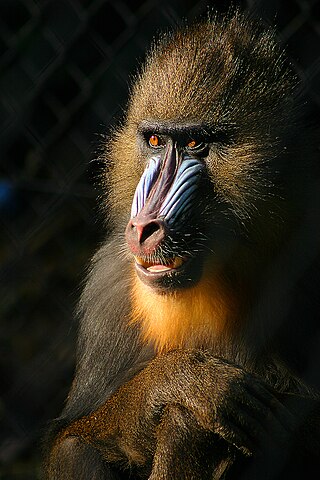
The Cercopithecinae are a subfamily of the Old World monkeys, which comprises roughly 71 species, including the baboons, the macaques, and the vervet monkeys. Most cercopithecine monkeys are limited to sub-Saharan Africa, although the macaques range from the far eastern parts of Asia through northern Africa, as well as on Gibraltar.

Australopithecus africanus is an extinct species of australopithecine which lived between about 3.3 and 2.1 million years ago in the Late Pliocene to Early Pleistocene of South Africa. The species has been recovered from Taung, Sterkfontein, Makapansgat, and Gladysvale. The first specimen, the Taung child, was described by anatomist Raymond Dart in 1924, and was the first early hominin found. However, its closer relations to humans than to other apes would not become widely accepted until the middle of the century because most had believed humans evolved outside of Africa. It is unclear how A. africanus relates to other hominins, being variously placed as ancestral to Homo and Paranthropus, to just Paranthropus, or to just P. robustus. The specimen "Little Foot" is the most completely preserved early hominin, with 90% of the skeleton intact, and the oldest South African australopith. However, it is controversially suggested that it and similar specimens be split off into "A. prometheus".
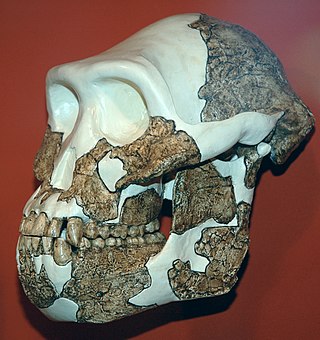
Australopithecus anamensis is a hominin species that lived approximately between 4.2 and 3.8 million years ago and is the oldest known Australopithecus species, living during the Plio-Pleistocene era.
A facultative biped is an animal that is capable of walking or running on two legs (bipedal), as a response to exceptional circumstances (facultative), while normally walking or running on four limbs or more. In contrast, obligate bipedalism is where walking or running on two legs is the primary method of locomotion. Facultative bipedalism has been observed in several families of lizards and multiple species of primates, including sifakas, capuchin monkeys, baboons, gibbons, gorillas, bonobos and chimpanzees. Different facultatively bipedal species employ different types of bipedalism corresponding to the varying reasons they have for engaging in facultative bipedalism. In primates, bipedalism is often associated with food gathering and transport. In lizards, it has been debated whether bipedal locomotion is an advantage for speed and energy conservation or whether it is governed solely by the mechanics of the acceleration and lizard's center of mass. Facultative bipedalism is often divided into high-speed (lizards) and low-speed (gibbons), but some species cannot be easily categorized into one of these two. Facultative bipedalism has also been observed in cockroaches and some desert rodents.
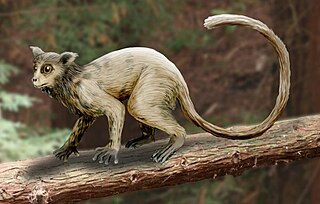
Necrolemur is a small bodied omomyid with body mass estimations ranging from 114 grams to 346 grams. Necrolemur’s teeth feature broad basins and blunt cusps, suggesting their diet consisted of mostly soft fruit, though examination of microwear patterns suggests that populations from lower latitudes also consumed insects and gums. While they do not sport a true tooth comb like modern lemurs, microwear patterns on their lower incisors suggest they engaged in fur grooming behaviors. Like tarsiers, Necrolemur had large, front-facing, close set eyes and were likely nocturnal. Analysis of cranial and postcranial fossils by paleontologists suggest members of the family Omomyidae, including the genus Necrolemur, possessed highly specialized adaptations for leaping.

Papionini is a tribe of Old World monkeys that includes several large monkey species, which include the macaques of North Africa and Asia, as well as the baboons, geladas, mangabeys, kipunji, drills, and mandrills, which are essentially from sub-Saharan Africa. It is typically divided into two subtribes: Macacina for the genus Macaca and its extinct relatives and the Papionina for all other genera.

Archaeolemur is an extinct genus of subfossil lemurs known from the Holocene epoch of Madagascar. Archaeolemur is one of the most common and well-known of the extinct giant lemurs as hundreds of its bones have been discovered in fossil deposits across the island. It was larger than any extant lemur, with a body mass of approximately 18.2–26.5 kg (40–58 lb), and is commonly reconstructed as the most frugivorous and terrestrial of the fossil Malagasy primates. Colloquially known as a "monkey lemur," Archaeolemur has often been compared with anthropoids, specifically the cercopithecines, due to various morphological convergences. In fact, it was even misidentified as a monkey when remains were first discovered. Following human arrival to Madagascar just over 2000 years ago, many of the island’s megafauna went extinct, including the giant lemurs. Radiocarbon dating indicates that Archaeolemur survived on Madagascar until at least 1040-1290 AD, outliving most other subfossil lemurs.
Gorgopithecus is an extinct genus of primate, in the old word monkey family Cercopithecidae, closely related to the baboons. There is only one known species, Gorgopithecus major. It has been found at sites from the Pliocene and Early Pleistocene Epoch in South Africa and Tanzania. It was first discovered at the Kromdraai A site in South Africa. It has since been found from Swartkrans, South Africa. Most recently, it has been recognized from the DKI site in Bed I of Olduvai Gorge, Tanzania, which has been dated to 1.8 million years old.

Dinopithecus is an extinct genus of very large primate closely related to the baboon that lived during the Pliocene to the Pleistocene epoch of South Africa and Ethiopia. It was named by British paleontologist Robert Broom in 1937. The only species currently recognized is Dinopithecus ingens, as D. quadratirostris has been reassigned to the genus Soromandrillus. It is known from several infilled cave sites in South Africa, all of early Pleistocene age, including Skurweberg, Swartkrans, and Sterkfontein.
Protopithecus is an extinct genus of large New World monkey that lived during the Pleistocene. Fossils have been found in the Toca da Boa Vista cave of Brazil, as well as other locales in the country. Fossils of another large, but less robust ateline monkey, Caipora, were also discovered in Toca da Boa Vista.
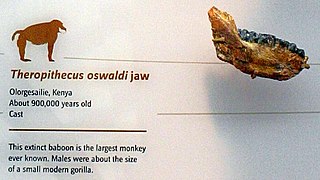
Theropithecus oswaldi is an extinct species of Theropithecus from the early to middle Pleistocene of Kenya, Ethiopia, Tanzania, South Africa, Spain, Morocco and Algeria. It appears to have been a specialised grazer. The species went extinct in South Africa around 1.0 Ma. Having existed alongside hominins like Homo erectus, it is likely that conflict with early humans played a role in their extinction as a site has been found with many juveniles butchered.

Anapithecus is a late Miocene primate known from fossil locations in Hungary and Austria. Many Anapithecus fossils come from the site of Rudabánya, in northern Hungary, where Anapithecus lived alongside the ape Rudapithecus. The only species in the genus, Anapithecus hernyaki, is named after Gabor Hernyák, chief geologist of the Iron Ore Works of Rudabánya.

Cercopithecoides is an extinct genus of colobine monkey from Africa which lived during the latest Miocene to the Pleistocene period. There are several recognized species, with the smallest close in size to some of the larger extant colobines, and males of the largest species weighed over 50 kilograms (110 lb).
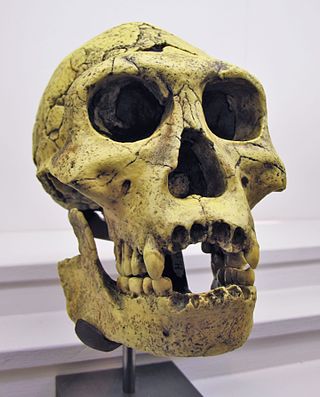
The Dmanisi hominins, Dmanisi people, or Dmanisi man were a population of Early Pleistocene hominins whose fossils have been recovered at Dmanisi, Georgia. The fossils and stone tools recovered at Dmanisi range in age from 1.85 to 1.77 million years old, making the Dmanisi hominins the earliest well-dated hominin fossils in Eurasia and the best preserved fossils of early Homo from a single site so early in time, though earlier fossils and artifacts have been found in Asia. Though their precise classification is controversial and disputed, the Dmanisi fossils are highly significant within research on early hominin migrations out of Africa. The Dmanisi hominins are known from over a hundred postcranial fossils and five famous well-preserved skulls, referred to as Dmanisi Skulls 1–5.
Pliopapio is an extinct genus of Old World monkey known from the latest part of the Miocene to the early Pliocene Epochs from the Afar Region of Ethiopia. It was first described based on a very large series of fossils from the site of Aramis in the Middle Awash, which has been dated by 40Ar/39Ar to 4.4 million years old. It has since been found from similarly aged sediments at Gona, approximately 75 km to the North. Additional fossils from the Middle Awash extend its known time range back to at least 5.3 million years ago. There is only one known species, Pliopapio alemui.
Rhinocolobus is an extinct genus of monkey closely related to modern colobus monkeys. It lived in eastern Africa during the Plio-Pleistocene, existing as recently as 1.5 million years ago.

Dolichopithecus is an extinct genus of Old World monkey that lived in Europe during the Late Miocene and Pliocene.


















